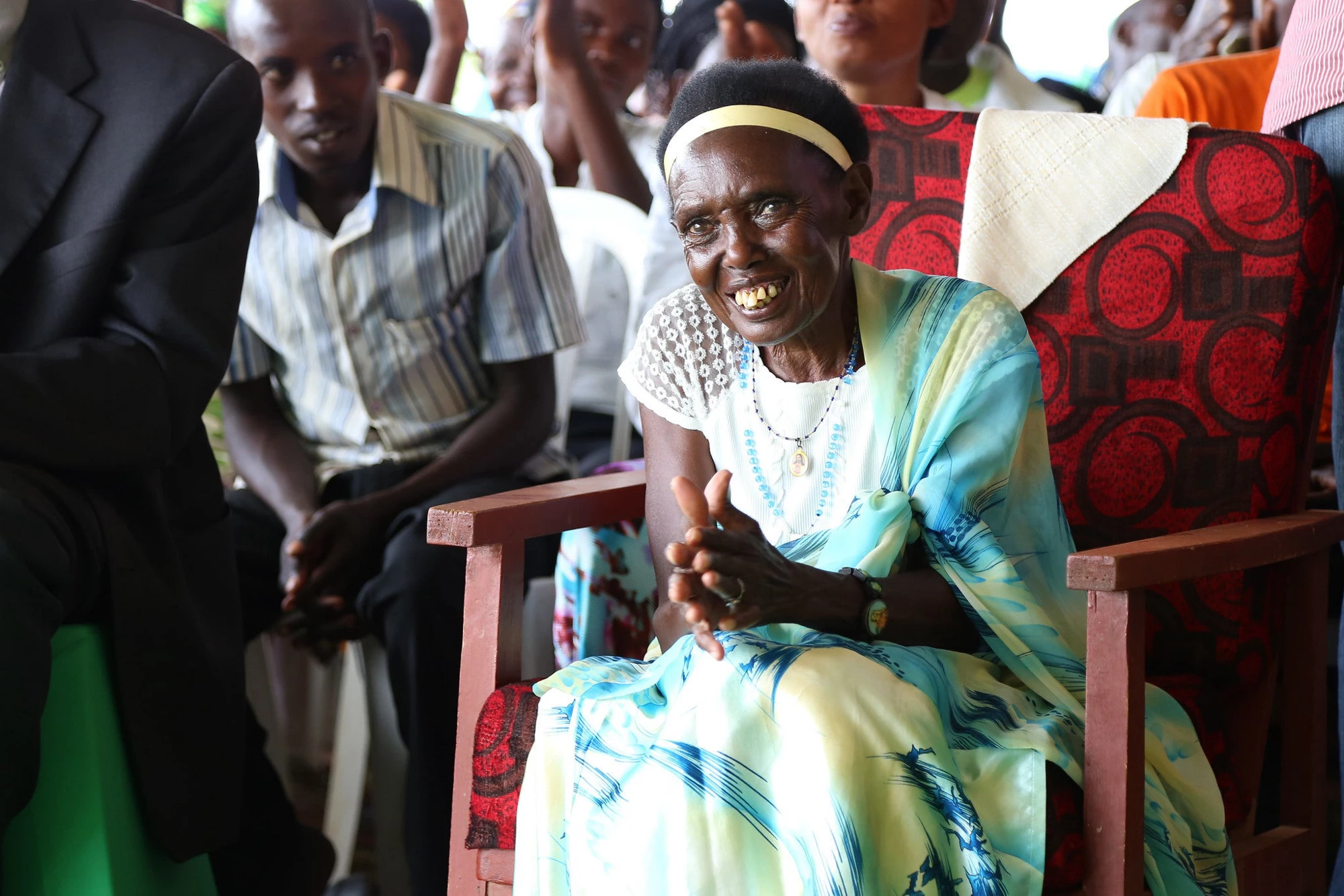 Bénéficiaire du programme Vision 2020 Umurenge du Rwanda (VUP), Susanne Nyiramahungura, 72 ans, a expliqué aux équipes de la Banque mondiale que ce programme lui avait donné une seconde chance dans la vie. Handicapée de naissance, Susanne remercie Dieu et le VUP de lui avoir permis de mettre de l'argent de côté et de vivre mieux. Photo : © Sarah Farhat/Banque mondiale
Bénéficiaire du programme Vision 2020 Umurenge du Rwanda (VUP), Susanne Nyiramahungura, 72 ans, a expliqué aux équipes de la Banque mondiale que ce programme lui avait donné une seconde chance dans la vie. Handicapée de naissance, Susanne remercie Dieu et le VUP de lui avoir permis de mettre de l'argent de côté et de vivre mieux. Photo : © Sarah Farhat/Banque mondiale
The COVID-19 pandemic has revealed numerous weak points in the systems of care throughout the world. While hitting all population segments worldwide, the pandemic threat is particularly high in the case of elderly and persons with disabilities , and responses have shown disproportionately lesser impact, resulting in dramatic consequences in terms of loss of lives, opportunities and inclusion. The elderly over 65 years account for nine percent of the world’s population and those over 80 years old account for almost two percent. Advanced age is linked to higher incidence of frailty and disability. Persons with disabilities (PwDs) comprise 15 percent of the world’s population and are more likely to be poor, less educated and be more exposed to economic insecurity and shocks. They are also more susceptible to infection and worse prognoses for recovery.
The residence arrangements and care needs of vulnerable populations are particularly challenging in the face of pandemic. Dependent people staying in care homes generally live in close and sometimes crowded quarters, facilitating the spread of the virus. That’s why many countries have enacted various measures to control infection and protect the elderly dependent on long-term care. These measures span from prevention and control measures, to management of human and financial resources, to reporting and coordination with public health authorities. They include such policies as daily symptom screening, social distancing requirements, visitor restriction, detection and quarantine procedures, enhanced disinfection regimes, staff training and protection, reporting procedures, clear leadership structures, awareness campaigns, and the adoption of other national or local guidelines and preparedness plans (see ltccovid.org for an excellent overview of these measures across different countries).
“Countries can learn lessons from this crisis on how to build and improve the social and elderly care systems.”
For people who receive home-based care, the pandemic has created significant additional burdens to familial caregivers, because most community-based services have closed to prevent the spread of virus. Some caregivers have been extremely strained as they deal with multiple burdens of care, job losses and other disruptions. For home-care recipients and familial care givers who do not reside jointly, lockdowns have posed especially dire dilemmas between compliance with lockdown measures and the provision of necessary help and care.
Countries can learn lessons from this crisis on how to build and improve the social and elderly care systems. Here are some lessons - both for the immediate response to protect those most vulnerable, as well as for the medium-term response to strengthen the health and safety of the frail elderly and PwDs and for the long-term reforms that aim to build efficient, equitable, and resilient care systems.
First, strengthen the health and safety of the social and aged care systems for the frail elderly and PwDs.
In the immediate term, measures are needed to manage possible further outbreaks and provide for care needs of dependent persons. Measures that have led to good results - including testing to prevent the spread and isolate the cases, making personal protective equipment (PPE) available to caregivers, and policies for managing the workload of and guaranteeing sick leave for caregivers - should be continued to safeguard persons in care homes. In parallel, existing social protection systems could be adapted to adequately cover paid sick leave; adjust the amounts of disability benefits and frequency of payments; and provide financial assistance for persons who stop working to support or to prevent contamination of their family members with disabilities and who are not covered by unemployment or sickness benefits to help those who are at home. The medium-term response would be to expand availability of formal home-based care and improve research and data to monitor, evaluate and strengthen health and delivery systems to meet the needs of elderly and persons with disabilities.
Second, improve government stewardship of the care market.
Countries with pre-existing publicly supported systems for the dependent elderly, PwDs, and other groups in need of care could mount a more effective response by building on these delivery systems. These systems can expand their outreach, thereby helping both care recipients and caregivers. The types of providers and the modalities of provider-financier arrangements that countries have are typically determined by specific country policies and conditions, but the crisis may prompt important conversations about the most suitable types for both. Good government stewardship is characterized by systems with functional funding channels, systems for measuring, enforcing and continuous improvement in quality of care across all ownership types of providers (which, in residential facilities, are strongly influenced by human resources deployed there), coordination between social and medical care, and information systems that transmit data upwards and downwards, among others.
Government stewardship is particularly important for the agenda in countries which already have provisions for social pensions and health care insurance and are thinking about developing structures for financing and provision of care. Leaving primary responsibility to the family or other private means imposes a high toll on the prime-aged familial cares (and women are overrepresented among them) and leads to inefficient use of medical resources. This crisis has shown that while the role of the family caregivers and private payment will remain important in many countries, government oversight and specific funding models appropriate to each country’s circumstances are needed to support the elderly and their families.
Third, use technological solutions to ensure continuity of care and battle isolation.
Telemedicine systems reduce possibilities of pathogen transmission while ensuring that ongoing and urgent medical needs of vulnerable persons can be met. Monitoring of vital signs and reminders to take necessary medications can be conducted using integrated wearable technology, reducing the need for physical contact with caregivers. Isolation, a problem for dependent people at all times with serious psychological and physiological consequences, has been heightened by social distancing measures, and can be addressed by better availability and usability of teleconferencing and other communication systems, specifically designed to meet the needs of the frail elderly and PwDs.
The harms that COVID 19 has caused to the frail elderly, PwDs, their families and caregivers are troubling. Already among the most vulnerable people in society, these groups’ need for contact with others to survive compounds their vulnerability to the pandemic. Government action that addresses the immediate needs of these person in this crisis is critical. Equally important are the development of systems and policies to mitigate future crises, including a possible second wave of COVID-19 outbreaks, and subsequent lingering health problems caused by the infection. Building resilient and accessible systems that prioritize both residential and home-based care, enhanced government oversight, and the smart incorporation of IT solutions and social protection systems can prepare societies to safeguard their dependent populations of frail elderly, PwDs, and others from this crisis and others in the future.
RELATED
- The World Bank Group and COVID-19
- World Bank Issues Paper on Persons with Disabilities in the COVID-19 Pandemic
- WHO Disability considerations during the COVID-19 outbreak
- The Elderly Care Response to Covid-19 : A Review of International Measures to Protect the Elderly Living in Residential Facilities and Implications for Malaysia
- World Population Prospects 2019
- World Data Lab: COVID-19
- A mortality perspective on COVID-19: Time, location, and age


Join the Conversation